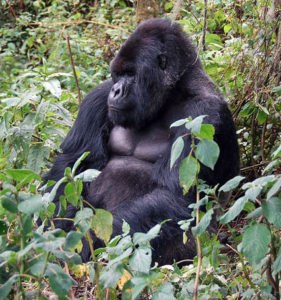The mountain gorilla has a robust build with long, muscular arms, a massive chest, and broad hands and feet. It is the hairiest race of gorillas; its long, thick black hair insulates it from the cold of living at high elevations.
The fur of the Mountain Gorilla, often thicker and longer than that of other Gorilla species, enables them to live in colder temperatures. Gorillas can be identified by nose prints unique to each individual. Males usually weigh twice as much as the females, and this subspecies is on average the largest of all gorillas. Adult males have more pronounced bony crests on the top and back of their skulls, giving their heads a more conical shape. These crests anchor the powerful masseter muscles, which attach to the lower jaw (mandible). Adult females also have these crests, but they are less pronounced. Like all gorillas they feature dark brown eyes framed by a black ring around the iris.
Mountain gorillas live in the misty mountain forests of Bwindi Impenetrable Forest and Mgahinga National Park, Uganda; Volcanoes National Park, Rwanda; Virunga National Park, DRC
Like all gorillas, mountain gorillas are very sociable and live in family groups led by the dominant silverback. They are largely herbivorous and eat a variety of shoots, fruit and leaves.
- The name Gorilla is derived from the Greek word Gorillai meaning hairy women.
- Today there remains only 10 countries (all within the western, central and Eastern Africa region) with naturally occurring gorilla populations.
- The Latin name for mountain gorillas is Gorilla Gorilla Berengei
- Mountain gorillas are only found in three countries in the world – Uganda, Rwanda, and DRC
- Mountain Gorillas are critically endangered specie. There are only about 720 mountain gorillas left in the world.
- Over half the world’s mountain gorilla population is to be found in Bwindi Impenetrable Forest in Uganda.
- Mountain gorillas are not known to survive outside their natural habitat, meaning that there are none to be found in zoos a round the world.
- Like humans, mountain gorillas have individual finger prints.
- The DNA of gorillas is 98%–99% identical to that of a human, and they are the next closest living relatives to humans after the two chimpanzee species.
- Females usually conceive at around 8 to 9 years with their first baby being born before age 10. Pregnancy lasts 8 and-a-half months.
- Gorillas follow a very strict pecking order, with the dominant silverback enjoying key privileges and first rights to all that is desirable in a gorilla’s world. For example, if a blackback or adult female chances upon an ant mound and begins to feast on the ants, should a silverback come by, without question, the lesser gorilla will allow the silverback first feeding rights.
- Gorillas live in tight knit social units – families, usually headed by a dominant silverback who determines where the group will range, eat, and sleep among other things.
- A silverback is a mature adult male gorilla
- A silverback can weigh up to 120Kgs (260lbs).
- On average an adult male gorilla eats up to 25 Kgs (about 54lbs) of food a day.
- The average weight of an adult female gorilla is 90Kgs (198lbs).
- Every evening, each gorilla makes a bed of leaves to sleep on for the night
- Gorillas never mate for leisure, their main aim is reproduction. This is proven by the fact that when a female is nursing, no male gorilla makes sexual advances at her.






4 Comment
McMillan, 2015-01-06 at 10:19 AM
It is nice that you posted all the vital information about gorillas, but i would be more glad if you post things like where to stay, what to wear, how to trek and all these.
Uganda Tourism Center, 2015-01-06 at 11:09 AM
Thank you in our next articles we shall give details.
Everest base camp trek, 2012-03-21 at 8:53 AM
Gorilla is a very big animal. Are they live only in mountains? Gorilla is a dangerous animal or not.
Jessica, 2011-12-27 at 5:10 PM
Am wondering if you would be able to tell me about how to track gorillas and how to act. What do you need to bring with you on the trips. I’ve been interested in gorillas for the longest time and some day I want to do gorilla trekking.If you could send some information out, it’d be great, Thanks Jessica